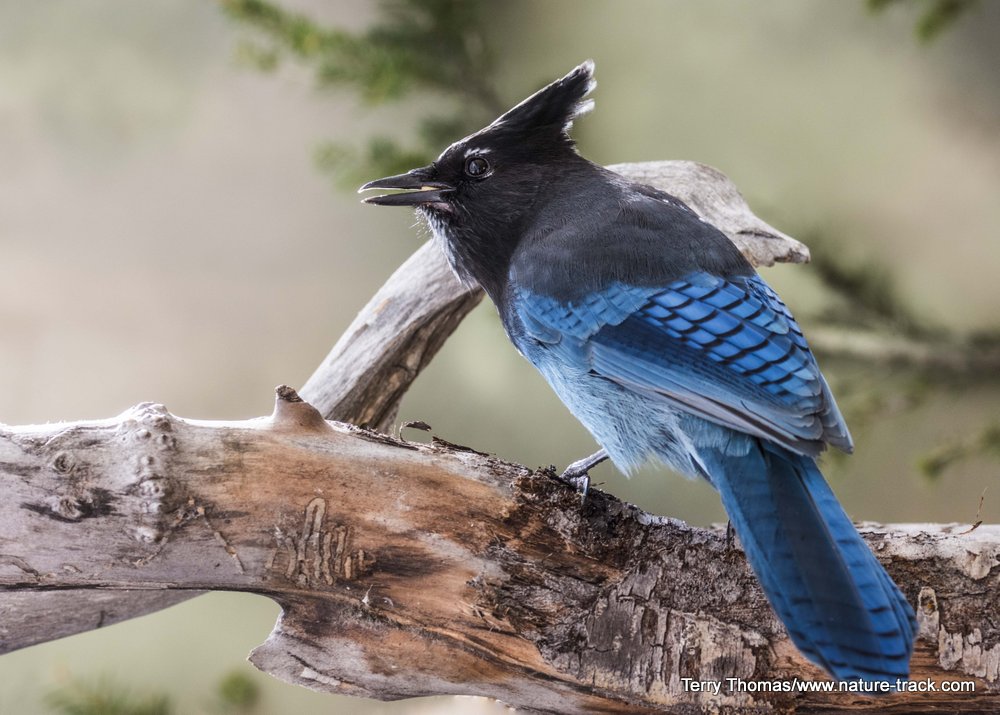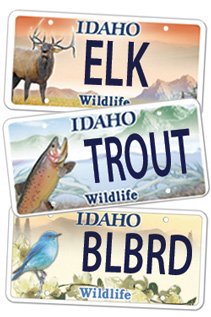Steller’s Jay

A Steller’s jay is a beautiful bird all year-round, but adds special color to the monochromes of winter.
Sitting in my blind at 20 degrees F is seldom easy. However, the bird action around my feeder was intense and I was kept busy enough photographing them that I didn’t notice the cold much. All of these were species I had rarely if ever seen at my feeders when we lived in the valley so it was exciting.
I heard what sounded like a red-tailed hawk call and wondered if the bird activity had finally attracted an opportunistic predator. After I had heard the call several times more and the birds around the feeder didn’t seem to react, I chanced a look out the side window of the blind. Instead of a hawk, to my surprise, I saw a Steller’s jay, a beautiful blue and black member of the corvid family and close relative of the blue jay. This was perplexing so I turned to my Audubon app and checked out the Steller’s jay. Sure enough, one of their calls was listed as a hawk imitation.
As it turns out, Steller’s jays have a lot of calls for communicating with other Steller’s Jays. However, they also mimic many forest sounds including squirrels, flickers, goshawks, nuthatches and even human-created sounds such as water sprinklers.
According to Cornell’s All About Birds website, Steller’s jay is probably one of the most frequently mis-spelled bird names. I even looked up the spelling and got it wrong at first. It does not have an “a” in the name. Steller’s jays were officially named in 1788 after Georg Steller, who was a naturalist aboard a Russian ship in 1741 where he was the first to describe a Steller’s jay he found on an Alaskan island. Steller’s sea-lion and Steller’s sea-eagle were also named after him.
Almost everyone who has visited us this winter has declared the Steller’s jay to be one of the most handsome of birds. Sexes are similar and in our neck of the woods; both have black heads, necks and backs. The body is a medium blue and the wings are blue with black barring, similar to a blue jay. There may be a white eyebrow and rakish somewhat indistinct white striping on the forehead and chin. Their most distinctive feature is a crest on the head, a feature shared with only one other jay, the blue jay. These two closely related species actually even interbreed where ranges intersect.
What is most interesting about their looks is how variable they can be. Some populations don’t have the black head and neck, but rather are blue throughout. Not all have white on the head either. Disparate looking populations may be side by side.
Despite their beauty, Steller’s jays, like most members of the Corvidae family, have a very dark side. They are common nest robbers, stealing and eating eggs and hatchlings. It that were not enough, they also occasionally attack and kill smaller birds. I haven’t seen any aggressive behavior at my bird feeders so maybe I am keeping them in a good mood with peanut butter. I know it always works with me.
You will find Steller’s jays in coniferous forests from southeastern Alaska to Central America. They are food generalists, eating insects, seeds, berries, nuts, and the aforementioned eggs and chicks. They are very social and vocal, keeping up a constant dialog with each other about forest events.
It has been worth braving some cold mornings to be able to watch Steller’s jays up close. I hope they stay around for the summer as well.
Help Idaho Wildlife
When we traveled across the state in October 2017, we visited most of the Idaho Department of Fish and Game wildlife management areas. Most of the vehicles we saw using the wildlife management areas did not have wildlife plates. Buying wildlife plates is a great way for non-hunters and hunters alike to support wildlife-based recreation like birding.
C'mon folks, let's help Idaho's wildlife by proudly buying and displaying a wildlife license plate on each of our vehicles!
See below for information on Idaho plates. Most states have wildlife plates so if you live outside Idaho, check with your state's wildlife department or vehicle licensing division for availability of state wildlife plates where you live.
And tell them that you heard about it from Nature-track.com!

Wildlife License Plates
Great news! as of 2024, there are three NEW designs for license plates. They still are bluebird, cutthroat trout and elk, but they are beautiful.
Idaho Wildlife license plates provide essential funding that benefits the great diversity of native plants and wildlife that are not hunted, fished or trapped—over 10,000 species or 98% of Idaho’s species diversity. Game species that share the same habitats (such as elk, deer, antelope, sage-grouse, salmon, trout) also benefit from these specialty plates.
No state tax dollars are provided for wildlife diversity, conservation education and recreation programs. Neither are any revenues from the sale of hunting or fishing licenses spent on nongame species. Instead, these species depend on direct donations, federal grants, fundraising initiatives—and the Idaho Wildlife license plates.
Both my vehicles have Bluebird Plates. I prefer the bluebird because the nongame program gets 70 percent of the money from bluebird plates, but only 60 percent of the money from elk and trout plates - 10 percent of the money from elk plates supports wildlife disease monitoring and testing programs (to benefit the livestock industry) and 10 percent from cutthroat plates supports non-motorized boat access.
Incidentally, in 2014, the Idaho Legislature denied the Department of Fish and Game the ability to add new plates or even to change the name of the elk and cutthroat plates (very specific) to wildlife and fish plates, a move that would have allowed for changing images occasionally and generating more revenue. It would seem that they believe that we Idahoans don't want a well funded wildlife program.
I think it is time we let the Legislature know that Idahoan support wildlife funding and that we would like to see these generic plates come to fruition.

"WOW. What a phenomenal piece you wrote. You are amazing." Jennifer Jackson
That is embarrassing, but actually a fairly typical response to my nature essays. Since The Best of Nature is created from the very best of 16 years of these nature essays published weekly in the Idaho Falls Post Register (online readership 70,000), it is a fine read. It covers a wide variety of topics including humorous glimpses of nature, philosophy, natural history, and conservation. Readers praise the style, breadth of subject matter and my ability to communicate complex and emotional topics in a relaxed and understandable manner.
Everyone can find something to love in this book. From teenagers to octogenarians, from the coffee shop to the school room, these nature essays are widely read and enjoyed.
Some of the essays here are my personal favorites, others seemed to strike a chord with readers. Most have an important message or lesson that will resonate with you. They are written with a goal to simultaneously entertain and educate about the wonderful workings of nature. Some will make you laugh out loud and others will bring a tear to the eye and warm your heart.
Readers Write:
"You hit a home run with your article on, Big Questions in Nature. It should be required reading for everyone who has lost touch with nature...great job!" Joe Chapman
"We enjoyed your column, Bloom Where Planted. Some of the best writing yet. The Post Register is fortunate to have your weekly columns." Lou Griffin.
To read more and to order a copy, click here or get the Kindle version
Copies are also available at:
Post Register
Island Park Builders Supply (upstairs)
Barnes and Noble in Idaho Falls
Harriman State Park, Island Park
Museum of Idaho
Valley Books, Jackson Wyoming
Avocet Corner Bookstore, Bear River National Wildlife Refuge, Brigham City, Utah
Craters of the Moon National Monument Bookstore, Arco, Idaho
Wildlife License Plates
Great news! as of 2024, there are three NEW designs for license plates. They still are bluebird, cutthroat trout and elk, but they are beautiful.
Idaho Wildlife license plates provide essential funding that benefits the great diversity of native plants and wildlife that are not hunted, fished or trapped—over 10,000 species or 98% of Idaho’s species diversity. Game species that share the same habitats (such as elk, deer, antelope, sage-grouse, salmon, trout) also benefit from these specialty plates.
No state tax dollars are provided for wildlife diversity, conservation education and recreation programs. Neither are any revenues from the sale of hunting or fishing licenses spent on nongame species. Instead, these species depend on direct donations, federal grants, fundraising initiatives—and the Idaho Wildlife license plates.
Both my vehicles have Bluebird Plates. I prefer the bluebird because the nongame program gets 70 percent of the money from bluebird plates, but only 60 percent of the money from elk and trout plates - 10 percent of the money from elk plates supports wildlife disease monitoring and testing programs (to benefit the livestock industry) and 10 percent from cutthroat plates supports non-motorized boat access.
Incidentally, in 2014, the Idaho Legislature denied the Department of Fish and Game the ability to add new plates or even to change the name of the elk and cutthroat plates (very specific) to wildlife and fish plates, a move that would have allowed for changing images occasionally and generating more revenue. It would seem that they believe that we Idahoans don't want a well funded wildlife program.
I think it is time we let the Legislature know that Idahoan support wildlife funding and that we would like to see these generic plates come to fruition.